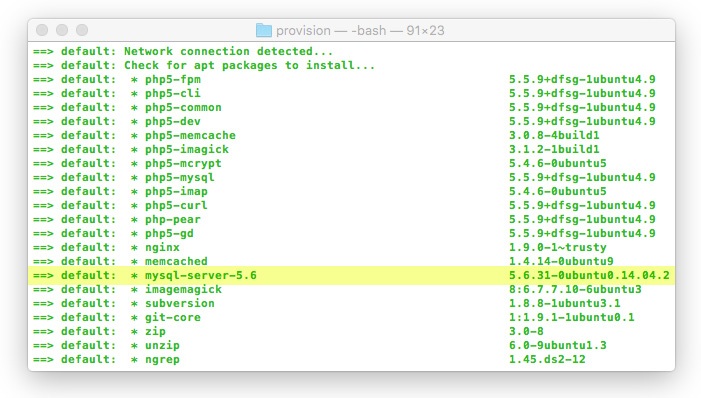
- INSTALL MYSQL ON MAC VIA VAGRANT HOW TO
- INSTALL MYSQL ON MAC VIA VAGRANT INSTALL
- INSTALL MYSQL ON MAC VIA VAGRANT SOFTWARE
- INSTALL MYSQL ON MAC VIA VAGRANT PASSWORD
We're beginning this article where the last one left off - with a brand new Ubuntu virtual machine set up. Connect to MySQL via SequelPro (or any database program).Link your local files with the virtual machine to be able to develop on the Vagrant environment from your local computer.View the server in a browser via IP address and custom domain name.
INSTALL MYSQL ON MAC VIA VAGRANT INSTALL
INSTALL MYSQL ON MAC VIA VAGRANT HOW TO
You will find instructions on how to do that in this guide to setting up VirtualBox and Vagrant with Ubuntu Server. A Vagrant/VirtualBox setup with an Ubuntu virtual machine.Please read How to Use the Command Line to get yourself acquainted if you're not already familiar. There are two prerequisites to complete before reading this tutorial. In this tutorial, we'll take an Ubuntu Server operating system that has been set up on Vagrant and install a LAMP stack on it. If you're working locally on Windows or Mac, and your server is on a Linux distribution, you may encounter bugs and errors that are specific to the operating system the server is running and you won't be able to troubleshoot them properly.įortunately, we have tools like Vagrant and VirtualBox that allow us to set up a virtual machine locally that can match the production environment. An easy way for beginners to do that is to set up MAMP on Mac or Windows, which sets up the environment for you.Īs you become a more advanced developer, you might need to create a local environment that matches your production server more closely. What next? Visit our MySQL tutorial section to create and manage databases from the command line.In order to run a server locally, we need to set up an environment for the stack, or server, database, and language, to run in. You have running MySQL server on your system. rver status # Show status of MySQL rver stop # Stop MySQL service rver start # Start MySQL service rver restart # Restart MySQL serviceĪll done. You can use rver command with options status, stop, start, or restart MySQL service on your system. There are rver command available under /usr/local/bin directory, which is used to manage MySQL service. Type '\c' to clear the current input statement. Other names may be trademarks of their respective Oracle is a registered trademark of Oracle Corporation and/or itsĪffiliates. Commands end with or \g.Ĭopyright (c) 2000, 2018, Oracle and/or its affiliates. Now, Connect to MySQL server using the command: mysql -u root -p You can use above file to customize your MySQL server. The main confiugration file is created at: Configuration file: /usr/local/etc/my.cnf The binary files are installed under /usr/local/bin directory and all the MySQL related files are created under “/usr/local/var/mysql” directory. MySQL server has been installed on your system.
INSTALL MYSQL ON MAC VIA VAGRANT PASSWORD
mysqladmin -u root password 'newpassword' Use the following command to set a new password. Now you just need to configure things so that your MySQL server is auto-started brew services start mysqlĪlso, you have to set a strong password for the MySQL root account. Wait for the installation process finish. Start a terminal and run command to install MySQL: brew install mysql

Here is the Homebrew installation tutorialĪt this time of writing this tutorial, Homebrew has MySQL 5.7.21 version in its main repository.

INSTALL MYSQL ON MAC VIA VAGRANT SOFTWARE


 0 kommentar(er)
0 kommentar(er)
